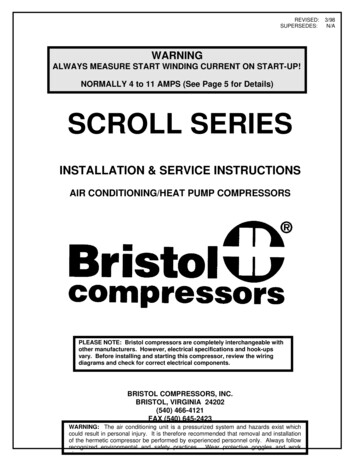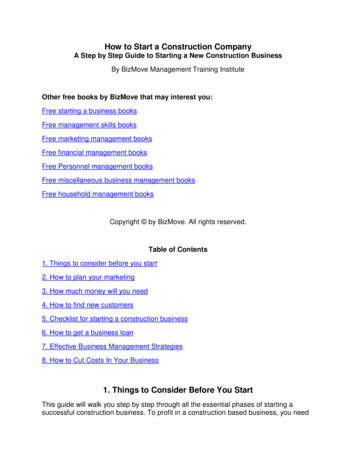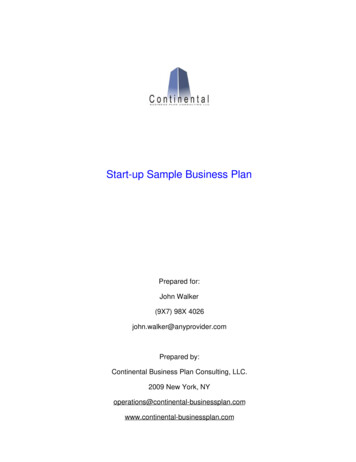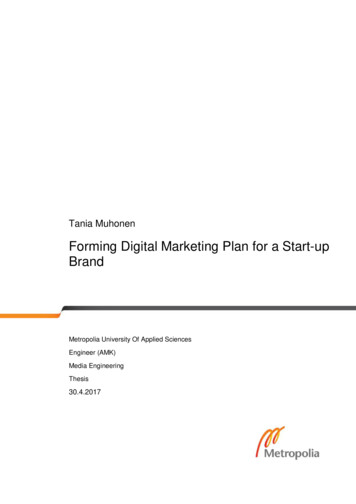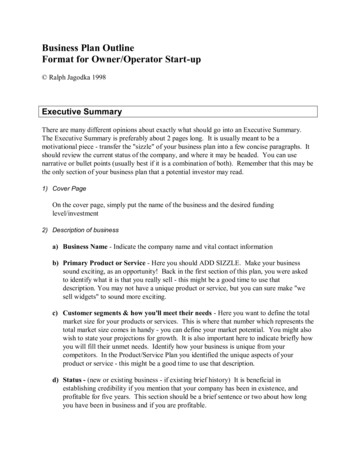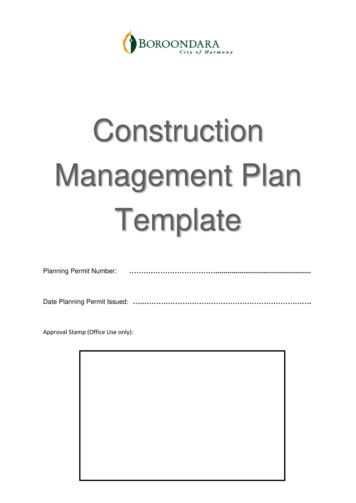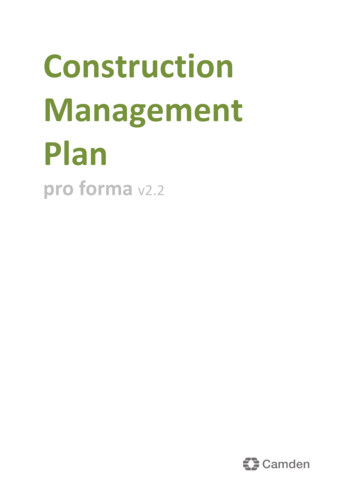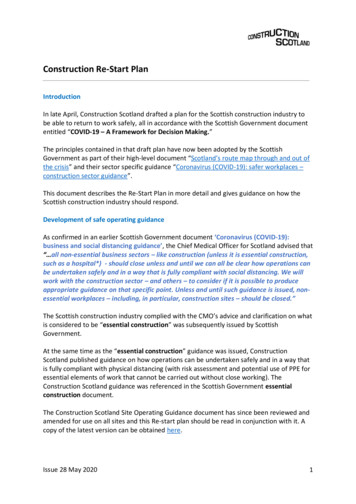
Transcription
Construction Re-Start PlanIntroductionIn late April, Construction Scotland drafted a plan for the Scottish construction industry tobe able to return to work safely, all in accordance with the Scottish Government documententitled “COVID-19 – A Framework for Decision Making.”The principles contained in that draft plan have now been adopted by the ScottishGovernment as part of their high-level document “Scotland’s route map through and out ofthe crisis” and their sector specific guidance “Coronavirus (COVID-19): safer workplaces –construction sector guidance”.This document describes the Re-Start Plan in more detail and gives guidance on how theScottish construction industry should respond.Development of safe operating guidanceAs confirmed in an earlier Scottish Government document ‘Coronavirus (COVID-19):business and social distancing guidance’, the Chief Medical Officer for Scotland advised that“ all non-essential business sectors – like construction (unless it is essential construction,such as a hospital*) - should close unless and until we can all be clear how operations canbe undertaken safely and in a way that is fully compliant with social distancing. We willwork with the construction sector – and others – to consider if it is possible to produceappropriate guidance on that specific point. Unless and until such guidance is issued, nonessential workplaces – including, in particular, construction sites – should be closed.”The Scottish construction industry complied with the CMO’s advice and clarification on whatis considered to be “essential construction” was subsequently issued by ScottishGovernment.At the same time as the “essential construction” guidance was issued, ConstructionScotland published guidance on how operations can be undertaken safely and in a way thatis fully compliant with physical distancing (with risk assessment and potential use of PPE foressential elements of work that cannot be carried out without close working). TheConstruction Scotland guidance was referenced in the Scottish Government essentialconstruction document.The Construction Scotland Site Operating Guidance document has since been reviewed andamended for use on all sites and this Re-start plan should be read in conjunction with it. Acopy of the latest version can be obtained here.Issue 28 May 20201
During the period of closure, the industry has taken the opportunity to review its sitearrangements, operating procedures and working practices and has developed SafeOperating Procedures to ensure that physical distancing can be observed (with risk assessedand controlled close working where necessary).These arrangements have been tested on the “essential construction” sites that havecontinued to operate and evidence of the implementation and use of these arrangementson essential sites, together with positive feedback from customers, has been received bythe Construction Leadership Forum Safe Operating Procedures working group.This group has also gathered evidence of the reviews conducted, procedures produced, andsite arrangements being made for re-start on non-essential sites.The conclusion from that evidence is that the industry has the expertise and capability andis ready to re-configure its workplaces to minimise the spread of the virus, and to work in aphysically distanced manner at all times (with risk assessed and controlled close workingwhere necessary).The role of PPEThe traditional process of managing risk on construction projects is to use risk assessment, aformally documented process through which identified hazards (such as Covid-19) aresubjected to a hierarchy of controls, with the use of PPE as the last resort once all othercontrols have been considered and implemented.This is the risk management process that is being used on all current “essentialconstruction” projects for any essential task that cannot readily be carried in a physicallydistant manner and that has been included within the Construction Scotland Site OperatingGuidance document.It is recognised however, that there is currently a shortage of “medical style” PPE (such asmasks and visors) and that, during a period of such shortage, it would be inappropriate forconstruction to base its operating model on the use of such PPE.The construction industry has proven ability to adapt and innovate in response to newchallenges and the challenge posed by Covid-19 will be no different. Therefore, untilinnovative working methods are developed to enable all activities to be carried out in aphysically distanced manner without “medical style” PPE, it is acknowledged that someactivities on non-essential construction should not be carried out until supplies arerestored to normal levels.The revised CS Site Operating Guidance has been written to reflect this position for nonessential construction.Issue 28 May 20202
The impact of physical distancing on the numbers of site personnelIn preparation for working within the physical distancing parameters (with risk assessed andcontrolled close working where necessary), contractors have had to review thecircumstances of each site individually. The planning work being done has shown that thenumbers able to work within physically distancing parameters on site after Re-start is drivenby the geography of the site, the nature of the project and its stage in development. Thelack of space on some sites means that it will only be possible to return to work at asignificantly reduced level of site resource. In some cases, this may be as low as 30% of theworkforce previously employed. The process of reinducting the workforce andfamiliarisation with the revised arrangements also mean that it may take 7 to 8 weeks tobuild up to that reduced level.The importance of “travel to work” planning (“door to door” control)It is important for industry to also note the importance of “travel to/from work” in theirCovid-19 planning. Our workforce has to be able to get to work safely and to not beperceived as a risk to the public in doing so. The industry will work with public transportproviders to determine and put in place arrangements for safely utilising this form of traveland also take steps to enable the use of private cars or physically distanced sharedtransport. Supportive plans will be put in place for people to get to sites, whether publictransport is available or not.Raising issues on siteEmployers have a duty to consult their people on health and safety. You can do this bylistening and talking to them about the work and how you will manage risks from COVID-19.The people who do the work are often the best people to understand the risks in theworkplace and will have a view on how to work safely.Involving them in making decisions shows that you take their health and safety seriously.You must consult with the health and safety representative selected by a recognised tradeunion or, if there isn’t one, a representative chosen by workers. As an employer, you cannotdecide who the representative will be.The industry will take steps to raise awareness of and promote use of sector wide “whistleblowing” websites and contact centres, in addition to any already set up on an individualcompany basis, through inductions, toolbox talks and publicity on sites.In particular, the HSE have set up a whistle-blowing line which can be found e 28 May 20203
The Re-start plan and overall approachThe plan proposed for the industry’s return to work is illustrated in Annex A.This plan describes a phased approach, reflecting the aims of “A Framework for DecisionMaking” by arranging a “managed transition from the current restrictions in a way thatenables suppression of transmission of the virus to continue” and the progressive return towork for which most of the industry is already preparing.The phasing is based on the work already done to determine the levels of resource that cansafely work on each site, with resources building progressively to that level as the workforceare inducted and as they gain experience of using the new safe systems.The Model defines the return to work in 6 phases, with different types of site progressingthrough Phase 1 ruction Phase 0: PlanningScotlandPhasingPhase 1Phase 2Phase 1: Pre-start PrepPhase 2: Soft startAll other PhasesPhase 0: PlanningThis is the phase the industry is currently in, when all contractors are preparing siteassessments for Covid-19 modifications, developing new procedures, risk and methodstatements and preparing to re-start. Experience is being gained through the “essentialconstruction” sites and through work being carried out elsewhere in the UK.Phase 1: Covid-19 Pre-start Site prepThe next phase is the advance preparation of sites in line with the new site procedures. Thework in this stage would be to facilitate physical distancing and enhanced hygiene and couldinclude such tasks as: Installing new or expanding existing site welfare and toilet facilitiesInstalling hand washing/sanitiser stationsAlterations to form “one way” systemsInstallation of Covid-19 signageMarking 2m distancing throughout the siteRe-modelling office and meeting rooms for physical distancingCleaning of all site facilities and the workspace“Road testing” all new systems prior to supply chain returning to siteIssue 28 May 20204
It is considered that, during this Phase, when numbers on site will be low, materialdeliveries to the site could commence, with controls as defined in the Site OperatingGuidance, being implemented.On a typical site, this work is likely to require no more than 10 operatives with 2 supervisorsto ensure adherence to physical distancing. An example of a programme for such works on atypical site – a school project – is attached as Annex B, together with some photographicevidence of the type of work to be carried out as Annex C.Phase 2: “Soft start” to site works (where physical distancing can be maintained)This phase begins when the site preparations are complete and when it is safe to do so inline with public health advice. It will consist of a progressive return of a proportion of theoriginal workforce to ensure that extended inductions, including site tours to explain thenew arrangements for hygiene and physical distancing, are able to be carried out.The health and safety of the workforce is of paramount interest to the sector and there willbe a phased return of a proportion of the workforce, brought back in “batches” to allow ahigh supervisor to worker ratio. This will allow extended inductions and site tours tofamiliarise the workforce with the new arrangements and allow time for those to become“the new normal.”As explained above, the number of workers able to return will depend upon the spaceavailable on site (both external areas and floorplates, if a building) and the welfare facilitiesthat have been provided. Contractors will have to adjust their site facilities and workplanning to ensure that physical distancing requirements are able to be met at each stage.During this phase, due to the shortage of medical style PPE supply, only work that can becarried out within physical distancing parameters or using protective barriers, will be carriedout. Risk assessment approaches will still be used to control the hazard of Covid-19 but ifthis shows that close working is still required and that protective barriers would beineffective, that work will not be carried out until supplies of medical style PPE are restoredto normal.This means that some tasks will not be able to be carried out, although the industry willmake strenuous efforts to develop innovative ways of completing critical tasks, workingwithin the new parameters.Issue 28 May 20205
Phase 3: Steady state operation (where physical distancing can be maintained)Phase 3 is the first of our phases to be included within Phase 2 of the Scottish Government’sroute map. Movement from the Scottish Government’s Phase 1 to Phase 2 will bepredicated on the criteria laid down in the route map document.In this phase, the site complement will have reached a steady state level and, dependingupon the site parameters, evidence suggest that this could mean that only 30% to 40% ofthe original workforce are able to be accommodated, due to physical distancing criteria.As in Phase 1, due to the shortage of medical style PPE supply, only work that can be carriedout within physical distancing parameters or with physical barriers will be carried out.Progress throughout Phase 3 will be subject to monitoring and supervision by sitemanagement, with any data/evidence gathered (such as site Covid-19 related absences)being used to inform continual review of management practices and arrangements toensure safe working and physical distancing.Phase 4: Steady state operation (with physical distancing, barriers or controlled closeworking with full PPE use)Phase 4 will only commence once we are advised that medical style PPE supply to the NHSand Social Care staff is assured. Once this key point is reached, the wearing of such PPE(with associated discipline, such as permits to work, time limits, PPE work zones and closesupervision) will be added to the range of measures available.This means that those tasks omitted in earlier phases will now be able to be completedProgress throughout Phase 4 will also be subject to monitoring and supervision by sitemanagement, with any data/evidence gathered (such as site Covid-19 related absences)being used to inform continual review of management practices and arrangements toensure safe working and physical distancing.Phase 5: Increasing density/productivity with experienceAs experience grows of working within the physical distancing parameters, sitecomplements may be able to increase, but only to a density that enables physical distancingto be maintained at all times and that ensures protection of the workforce.Cascade to micro businesses and the domestic sectorPrincipal contractor
Construction Re-Start Plan Introduction In late April, Construction Scotland drafted a plan for the Scottish construction industry to be able to return to work safely, all in accordance with the Scottish Government document entitled “COVID-19 – A Framework for Decision Making.” The principles contained in that draft plan have now been adopted by the Scottish
